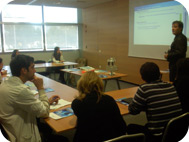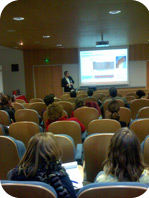LabCluster
Tour "Innovations en Single-cell, Transcriptomique et Biologie
spatiale"
Jeudi 1er juin 2023 • 9h00 - 15h30 |
|
La participation est gratuite sur inscription Il est possible de s'inscrire à la totalité de la matinée ou seulement à une ou plusieurs conférences.Evénement organisé dans le respect des mesures sanitaires et des gestes barrières. |
|||||
| Cliquez ici pour vous inscrire |
|
||||
Thème de la demi-journée :
| TRANSCRIPTOMIC,
SINGLE-CELL, SPATIAL BIOLOGY |
||||||
Programme :
| |
Accueil café dès 8H30 9H00- 9H30 Vizgen Decipher Tissue Complexity with Spatial Genomics: Single Cell Spatially Resolved Transcriptomic Imaging with MERSCOPE Powered by MERFISH Biological systems are made of numerous cell types, intricately organized to form functional tissues and organs. While recent advancements in genomics technologies have made it possible to characterize cell types through careful analysis of the transcriptome, they are unable to resolve how gene expression and cell types are spatially arranged. In this presentation, you will learn about Vizgen’s all-in-one in situ genomics platform MERSCOPE which enables the direct profiling of the spatial organization of intact tissue with genomic scale throughput. The instrument, the MERFISH chemistry and use cases will be presented as well. 9H30-10H00 Rarecyte Unlocking Spatial Biology with Orion™ Orion™ is a novel spatial biology platform enabling whole-slide immunofluorescence and same-section H&E imaging results for up to 20 biomarkers in a single-round tissue staining step. Orion imaging is achieved in less than 2 hours per sample, making the approach suitable for translational and clinical research. 10H00-10H30 Standard Biotools The Hyperion™ Xti Imaging System: The gold standard in high-plex immunohistochemistry Les bénéfices de la technologie à travers notre nouvelle solution : l'Hyperion™ XTi. La technologie CyTOF apporte des bénéfices uniques en imagerie tissulaire et en cytométrie. L'hyperion XTi intègre complètement les 2 visages de cette technologie. 10H30-10H45 PAUSE 10H45-11H15 Lunaphore Mapping the spatial heterogeneity of the tumor microenvironment with novel hyperplex immunofluorescence Novel technologies focused on delivery of single-cell data, have shed new light on biological processes and brought many exciting findings into life science research. In order to allow pushing the boundaries of research and to fill the high demand for it, easy access to omics technologies is needed. Lunaphore carries out efforts to fill that gap and bring spatial context to single-cell assays by enabling hyperplex immunofluorescent method in an “end-to-end" fashion. The fully automated staining-imaging COMET™ platform enables the interrogation of 40+ biomarkers in each run, on the same tissue slide with sequential immunofluorescence (seqIF™) assays. Guided workflow optimization and flexibility of the system to use the off-shelf reagents allow fast and easy adoption of the methodology in every laboratory. Lunaphore accompany their customers during data generation and analyses with HORIZON™, an intuitive image analysis platform tailored to support users for the processing of hyperplex immunofluorescent images. 11H15 - 11H45 Bio-Techne The RNAscope assay: the easiest way to perform robust spatial transcriptomic at the single cell level With more than 8000 publications, RNAscope is the spatial transcriptomic method the most used to date. With RNAscope you can visualize any targets, on any tissues, in any species at the single cell level with a probability of success close to 100%. The technic is easy to implement in your lab as there is no need to buy costly equipments, no need to follow particular training and no need to optimize the protocol. In consequence, RNAscope is accessible to anybody ! In addition to the fact that the technique is specific and sensitive, it is possible to detect from 1 to 48 mRNAs and to combine mRNA and protein detection on the same biological sample (cells, FFPE/fixed-frozen/fresh frozen cross-sections, whole-mount, embryos…). The technic has been widely used during the past decade (1) as an alternative to IHC/IF (cells, pathogens, targets bio-distribution) (2) to confirm transcriptomic datas (qPCR, scRNAseq,…) and (3) to characterize the activation states of cells in situ. After the seminar, please come to see us at the Bio-Techne booth to discuss your research project. •••••••••••••••••••••••••••••••••••••••••••••••••••• 14H00 - 14H30 Do Bio Microfluidics in Life Science: Using droplets to capture high resolution genetic information from cells Microfluidic instrumentation enables precise manipulation of fluids, which can be used to generate picolitre sized droplets. These droplets can act as micro-compartments to capture individual/multiple cells and their genetic material, in a high throughput and reproducible manner, giving much higher resolution of biological systems over traditional batch methods. Using microfluidics to encapsulate cells reveals high quality information regarding cellular heterogeneity, leading to the identification of novel cellular sub-populations and gene expression patterns. This information can be used to understand disease progression, immunity, tumor evolution or even microbiome structure. Droplet genomics can be adapted for a wide range of research areas: single-cell RNA sequencing, single-cell multi-omics, heavy chain-light chain pairing, single cell genome sequencing or the production of high molecular weight DNA. Do Bio is known for its innovative products within the droplet genomics research field. The Nadia product family includes a range of instrumentation and reagent kits which allow users to perform standardised droplet genomic protocols or develop their own. 14H30 - 15H00 Nanostring Map your Tissue Sections at Any Scale with NanoString’s Spatial Platforms The CosMx Spatial Molecular Imager (SMI) is the first high-plex in situ analysis platform to provide spatial multiomics with formalin-fixed paraffin-embedded (FFPE) and fresh frozen (FF) tissue samples at cellular and subcellular resolution. CosMx SMI enables rapid quantification and visualization of up to 1,000 RNA and 64 validated protein analytes. It is the flexible, spatial single-cell imaging platform that will drive deeper insights for cell atlasing, tissue phenotyping, cell-cell interactions, cellular processes, and biomarker discovery. The GeoMx Digital Spatial Profiler (DSP) provides morphological context in spatial transcriptomics and spatial proteomics experiments from just one slide. From discovery to translational research, the GeoMx DSP is the most flexible and robust spatial biology solution designed to conform to your ever-changing research needs. 15H00 - 15H30 10X Genomics Empowering Impactful Science with Leading Edge spatial Technologies : Xenium Assessing gene expression with morphological context is critical to our understanding of biology and the progression of disease. Historically, it has been challenging to spatially interrogate complex heterogeneous tissues in a high-throughput manner, especially without previously generated assumptions about the genes being expressed. With Visium Spatial products researchers can now map the whole transcriptome for entire H&E- or immunofluorescently stained fresh frozen or FFPE tissue sections with morphological context. And now with the Xenium platform you can get new insights into cellular structure and function by performing high-throughput mapping of 100s of RNA targets in their true tissue context. The platform includes a versatile and easy-to-use instrument, sensitive and specific chemistry, a diverse menu of customizable panels, and powerful visualization software.Join us to learn how Spatial products from 10x Genomics give you a comprehensive understanding of the relationships between cellular function, phenotype, interactions, and location in intact tissue sections. |
||
|
Stands de démonstration et d'information toute la matinée. Venez nous rencontrer. |
|||

| Le nombre de places étant limité, il est fortement conseillé de s'inscrire à l'avance en cliquant ici |
|
|||
| Pour toute question ou demande d'information, cliquez ici | |
![]()



